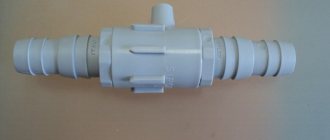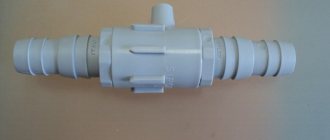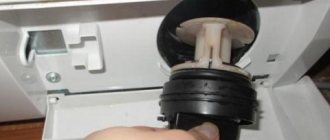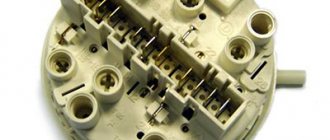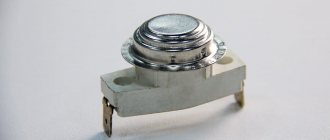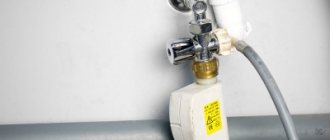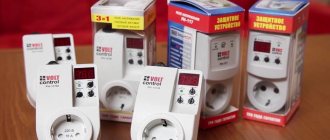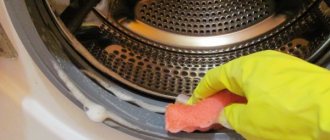Solenoid valves for connecting various devices to water supply systems are used quite often. Such devices have an electromechanical principle of operation and are a type of locking equipment. Experts call them solenoid (solenoid - magnet).
Solenoid shut-off elements are often found in various industries, in water and gas supply systems. In accordance with its functions, in washing machines this device is called a filler or inlet valve.
Purpose of the inlet valve
All washing machines such as Indesit, Samsung, Ariston, Zanuzzi and other models are necessarily equipped with a solenoid valve.
This device has two operating states: open and closed. As soon as the washing program is selected, the mechanism of the electromagnetic device will work and open, after which water will begin to flow. The volume of water is controlled by an electronic module, which in turn controls the operation of the pressure switch and the inlet solenoid valve. The filling device is activated by supplying power from the control unit to the coil of this device.
The water supply valve for a washing machine acts as a shut-off valve, essentially a tap that opens and shuts off the flow of water into the washing tank through a container with detergents at the right time, according to the washing mode.
Valve replacement
- First of all, the washing machine must be disconnected from the power supply and the water turned off. Then remove the back wall.
- All hoses and wires are disconnected from the inlet valve. Whatever you forget, where it goes, it’s better to write it down, sketch it or take a picture.
- Then the valve is released from the fasteners. The bolts that secure it are unscrewed or the latches are bent. They also have a place in some models.
- In order to remove the valve, it must be turned.
- Installation of the intake valve is carried out in reverse order.
After installing the new part, you should once again check that the wires and hoses are connected correctly, and only then turn on the washing machine.
Water supply valve device
The inlet solenoid valve of a household washing unit is a small device consisting of:
- housings;
- electromagnetic coil with core;
- springs;
- a disk mounted on a core that blocks the flow of water coming from the water supply.
The body material in most cases is various types of heat-resistant polymer materials, less often brass or stainless steel. For the manufacture of membranes, gaskets and seals, heat-resistant rubber, caoutchouc, fluoroplastic or silicone are used. Electric magnets with rigidly fixed parts (solenoids) are installed in the retractor coil. Depending on the number of solenoids, they can be one, two, or three-coil. The number of coils corresponds to the number of sections of the device through which tap water flows into the dispenser. Electromagnetic valves of washing machines from different companies may differ in materials of manufacture, appearance or number of coils, but the operating principle of all such elements is the same.
Signs of breakdown
The malfunction can be determined by external signs:
- Error code on the washing machine display.
- Water is drawn into the tank without stopping.
- When starting the machine, there is no sound of water intake.
- The tank is overflowing with water.
Read more about how to check and replace the inlet valve of a washing machine below.
How to find the problem yourself
Before checking the solenoid valve, inspect the mesh filter. It is located between the intake hose and the inlet valve and serves to retain particles of debris coming from the water supply.
Since the filter could become clogged over time, we will describe the principle of cleaning it:
- Disconnect the CM from the power supply.
- Close the inlet valve.
- Unscrew the inlet hose and drain the remaining water from it into a sink or other container.
- Behind the hose you will find a mesh. Pull it out using pliers and clean it under running water.
Let's look at how to open and check the inlet valve in a washing machine.
- Remove the lid on the top of the washer. To do this, unscrew the screws from the back that hold the top cover.
- Inspect the valve for damage. If nothing is visible from the outside, remove the device.
- Disconnect the hoses leading to the valve. First you need to loosen the metal clamps, so use pliers.
- Now disconnect the wiring.
- Unscrew the bolts securing the part to the SMA body.
- Pull out the valve.
Inspect the hoses and the device itself for blockages. How to check the fill valve? Check over a container or sink to avoid getting wet on the floor.
Connect the intake hose to the valve and open the water. If the element is working properly, it should not leak water. If it leaks, then replacement is needed.
The next test option must be carried out quite carefully. You must apply a voltage of 220 Volts to the coils of the device. In this case, the section should open and fill the container with water. The danger of this method is that when electricity and water come into contact, a short circuit may occur. Therefore, you need to work very carefully.
You can accurately determine whether the washing machine valve needs repairs using a multimeter. Set the tester to resistance measurement mode. Apply probes to each winding one by one, measuring its resistance. A working part should show a result of 3 kOhm.
Working principle of water supply valve
The inlet valve of the washing machine is controlled by the control module. In a stationary position, when no voltage is applied to the coil, the valve is closed, and its membrane, due to the spring, is in hermetically sealed contact with the seat of the device, reliably shutting off the pressurized water in the water supply. When the processor sends an electrical signal to the coil, the rod, under the influence of an electric field, is drawn into it, dragging the piston along with it. The device moves from the static “closed” position to the “open” position. When the electric current supply is interrupted, the rod returns to its previous position and the water supply is interrupted. All coils of household washing units are designed for a normal voltage of 220 V and a clock frequency of 50 Hz.
Technically outdated samples were equipped with a single-coil electric valve, in which the flow of water into various sections of the plastic dispenser was carried out through the lever of a mechanical command device. In modern machines equipped with two- or three-coil types, under the control of the processor, one of the coils is turned on, ensuring the supply of water to the required section of the dispenser. In two-coil versions, both coils are turned on simultaneously to supply water to the third section of the dispenser.
When the required amount of water enters the tank of the washing unit, a special device called a pressure switch sends an electrical signal to the control module. Having received the signal, the module turns off the voltage from the coil or coils of the device. The valve closes, cutting off the flow of water. In all washing modes the process is repeated.
Washing machine valve - why is it needed?
Protects the washing machine from the movement of water from the sewer into the tank.
The machine draws water from the hydraulic system and discharges the soap solution into the sewer. The valve ensures that water flows into the sewer after washing, and not vice versa: from the sewer into the washing drum. The device is designed in such a way that when water tries to flow back, the part blocks the path.
The drain valve for the washing machine saves electricity.
Without this accessory, water would be delayed at some stages of its route, which would lead to excessive energy consumption.
Types of intake valves
Water supply valves for LG, Samsung or Indesit washing machines may have various technical differences. Almost all manufacturers install normally closed valves on their units. Normally closed valves are valves that open when voltage is applied to the electromagnetic coil.
The inlet valves of washing machines can be divided into:
By the number of electromagnetic coils
- single-reel (outdated washing units);
- two-reel (most budget models);
- three-reel;
- four and five reel (some models);
2. Based on the materials used to manufacture the case
- plastic;
- metal.
3. According to the sizes of water supply fittings
- 1/2in;
- 3/4 inch;
There is also a universal fill valve for washing machines on sale, marked 1/90, which means there is one outlet located at an angle of 90 degrees relative to the inlet fitting. The metal mounting plate of such a valve is removable and can be adjusted at different angles. The diameter of the solenoid valve nipple is 10.5 mm, and the inlet fitting is ¾ inch. This universal solenoid valve is suitable for washing units from most manufacturers that have a single-coil version of the device installed.
What are the types of valve related problems?
The inlet valve, like any electrical and mechanical part, is susceptible to breakdowns. The washing machine stops drawing water. Main reasons:
- failure of the coil (water either does not enter the washing machine or flows without stopping)
- if the machine is in the country, then due to accumulated water and temperature changes, the electromagnetic device bursts
- intake valve screen clogged
As for repairs, in theory the fill valve cannot be repaired. You can independently remove the coil from the entire valve and insert it into a new one, but this does not guarantee normal and long-term operation of the washing machine. Instead of wasting time and money, it is better to immediately replace the old valve with a new one.
Malfunctions of inlet valves and their replacement
If the washing unit has been idle for a long time and tap water has accumulated in the washing drum, the inlet valve most likely needs to be replaced. If the washing unit, for some reason, was left in a room with sub-zero temperatures, then due to the freezing of the water accumulated in it, the body of the device may crack. In this case, it is also changed entirely.
If the water supply is poor, sometimes it is enough to clean the filtration mesh to restore operation. To do this, you need to turn off the water and remove the water supply hose and remove the contamination by pulling out the mesh with pliers and then putting it in place.
The main malfunction of solenoid valves is a malfunction of the electromagnetic coil. If the coil is burnt out and does not retract the rod, water does not flow into the washing tank at all. Most modern units are equipped with electric valves that have a non-separable design, so they cannot be repaired. It is better to carry out replacement with the assistance of a specialist. You can carry out the repair yourself by purchasing a new filling electric valve, similar to the one that failed. To do this you need:
- turn off the power to the washing unit;
- turn off the water supply and disconnect the water supply hose;
- remove the lid or side wall (for top-loading machines) of the washing machine;
- disconnect the electrical wiring and hose (or hoses) associated with the dispenser section;
- unscrew the fixing plate bolts;
- remove the device;
- check performance using a multimmmeter. The winding of a single-coil valve should “ring” at 3.8 kOhm (on older Samsung models 4.5 kOhm), for double and triple coils this figure ranges from 2 to 4 kOhm;
- Replace the solenoid valve with a new one, reassembling it in the reverse order.
Possible faults
The following malfunctions may occur:
- Filter mesh clogged. It must be carefully inspected and, if necessary, cleaned of dirt and rinsed with water.
- The coils should be checked for serviceability. If voltage is applied to them, but the valve is still in the closed state, then a break is possible. Or the part burned out. A multimeter will help diagnose such a malfunction. The device is switched on in resistance measurement mode and connected to the ends of the coil. The serviceability of the part will be indicated by a resistance of 2 - 4 kOhm.
- Be sure to check the plastic inserts in the fittings that restrain the water pressure; if they are broken or missing, the part must be replaced.
Repairing the inlet solenoid valve is most often not possible, since it is a non-separable part that requires complete replacement in case of malfunction. Although some craftsmen replace a failed coil with a serviceable one, if available.
The best option in this case would be to purchase a new inlet solenoid valve, and subsequently install it in the washing machine.
